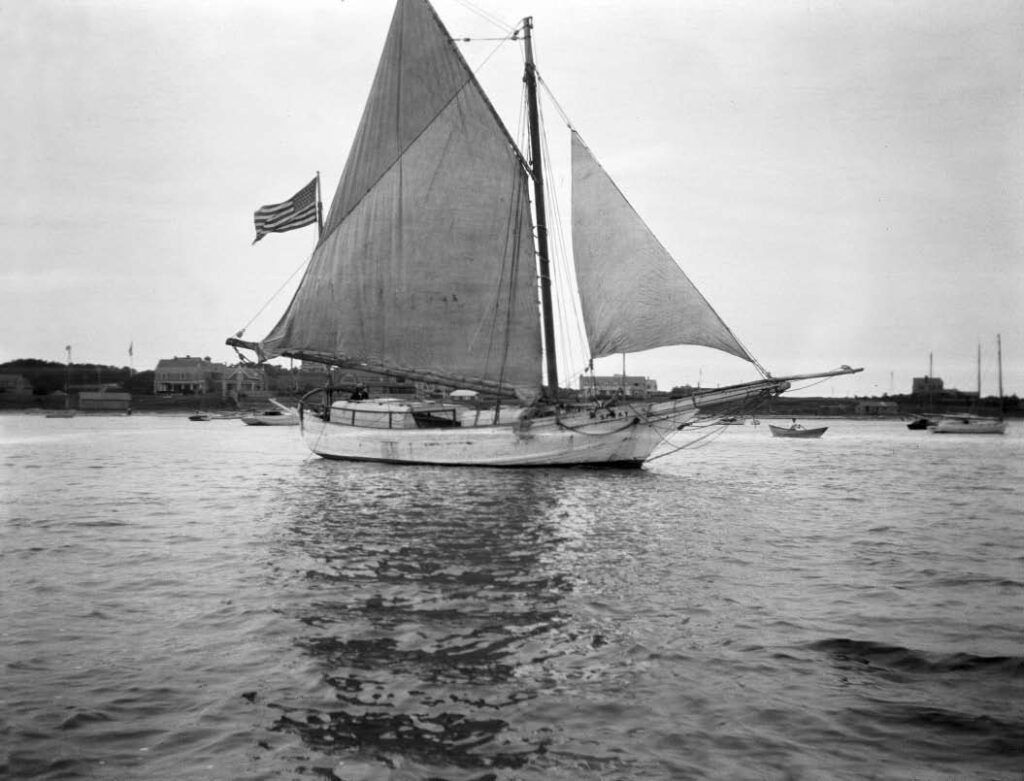Joshua Slocum was born February 20, 1844 in Nova Scotia, Canada. As far as anybody knows, he was the first person to sail around the world alone. A lot of people do know about Slocum, though, because after he got back in 1900 he wrote a best-selling book, Sailing Alone Around the World.
The Slocum family had lived farther south in North America, but opposed the US War for Independence and migrated to Nova Scotia along with many other British loyalists. Most of the loyalists, including Slocum’s father, were granted 500 acres of farmland. At the time, by the way, the family name was “Slocumb,” but Joshua dropped the “B” as an adult.
Although his father was a farmer, Joshua Slocum was more interested in boats, and ran away to sea when he was 14. He signed on to a fishing boat as a cabin boy and cook. That wasn’t quite what he expected, though, and he returned home, where he stayed for two years before once again hiring on to a ship — this time a merchant ship bound for Europe. This time he became an “ordinary seaman.”
He stayed at sea for the next two years, and studied for the Board of Trade examination, which earned him the position of Second Mate at 18. Before long he was a Chief Mate serving on British trade ships. In the 1860s, his home base became San Francisco, and he became both a captain (of eight different ships), four of which he owned. He got married in 1871 in Sydney, Australia — and he and his new wife left on the ship Constitution (not the famous US naval warship) the very next day.
Slocum became known for both bravery and resourcefulness when another ship he captained, the Washington, was wrecked in a storm. Slocum managed to single-handedly rescue all the people aboard, then organized the crew and used the life boats to save most of the cargo. That eventually led to owning his own ships, which he and his wife lived on, eventually with their four children. One of the ships was the Aquidneck, which traveled between San Francisco and Buenos Aires. While there, Slocum’s wife died of an undiagnosed disease. On another voyage, most of the crew caught cholera. After that the ship was attacked by pirates (they managed to fight them off), and then some of the crew caught smallpox. Finally, around 1887, the ill-fated Aquidneck was wrecked in southern Brazil.
That left Slocum, his wife (he had remarried), and two of his sons stranded. Slocum salvaged materials from the Aquidneck, built a 35-foot boat (the Liberdade), and sailed home. It was a voyage of 5500 miles. That was enough for his second wife, though; she never boarded another ship. It was also a turning point for Slocum; in 1890 he wrote his first book, Voyage of the Liberdade, about his homemade boat and their trip.
Building the Liberdade and writing a book about it may have motivated Slocum to spend 1891 and 1892 rebuilding a 36-foot boat, the Spray. In April, 1895, he set sail in it from Boston. Sailing Alone Around the World begins “I had resolved on a voyage around the world, and as the wind on the morning of April 24, 1895 was fair, at noon I weighed anchor, set sail, and filled away from Boston, where the Spray had been moored snugly all winter.” Slocum was able to sail the Spray without having to do any manual steering, for the most part. The boat was designed so that it stayed on course as long as the sails were set correctly. According to his book, he crossed 2000 miles of the Indian Ocean without once touching the helm.
Slocum returned home three years later, but didn’t get much recognition because the Spanish-American War had just started. A few months later it was over, and at that point Slocum’s feat started appearing in headlines. He published his book starting the next year, initially as serialized articles in Century Magazine. He had in fact made his book deal before leaving on his journey, and had sent the publisher several letters along the way. His book was an international best seller, and provided him financial independence — and he bought a farm, but found he could no longer stand living on land. He kept sailing the Spray among various ports, selling books and giving talks. Around 1909 he made plans for a new major voyage (and a new book), and left — but he was never heard from again. Slocum was inducted into the National Sailing Hall of Fame in 2011 (I bet you never heard of that hall of fame!), and is the subject of exhibits in several maritime museums. Countless yachts and other vessels are named Spray, Joshua, and Joshua Slocum. And if you visit Dartmouth, Massachusetts, you can see the Slocum River.

